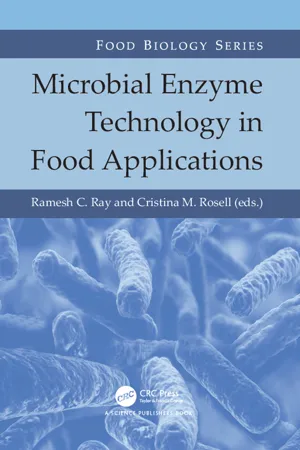
Microbial Enzyme Technology in Food Applications
Ramesh C. Ray, Cristina M. Rosell, Ramesh C. Ray, Cristina M. Rosell
- 520 pages
- English
- ePUB (mobile friendly)
- Available on iOS & Android
Microbial Enzyme Technology in Food Applications
Ramesh C. Ray, Cristina M. Rosell, Ramesh C. Ray, Cristina M. Rosell
About This Book
The aim of food processing is to produce food that is palatable and tastes good, extend its shelf-life, increase the variety, and maintain the nutritional and healthcare quality of food. To achieve favorable processing conditions and for the safety of the food to be consumed, use of food grade microbial enzymes or microbes (being the natural biocatalysts) is imperative.
This book discusses the uses of enzymes in conventional and non-conventional food and beverage processing as well as in dairy processing, brewing, bakery and wine making. Apart from conventional uses, the development of bioprocessing tools and techniques have significantly expanded the potential for extensive application of enzymes such as in production of bioactive peptides, oligosaccharides and lipids, flavor and colorants. Some of these developments include extended use of the biocatalysts (as immobilized/encapsulated enzymes), microbes (both natural and genetically modified) as sources for bulk enzymes, solid state fermentation technology for enzyme production. Extremophiles and marine microorganisms are another source of food grade enzymes. The book throws light on potential applications of microbial enzymes to expand the base of food processing industries.
Frequently asked questions
Information
PART 1
HISTORY
1
Microbial Enzymes in Food Applications
History of Progress
Swati S. Mishra,1,* Ramesh C. Ray,2 Cristina M. Rosell3 and Debabrata Panda1
1. Introduction
2. Enzymes
2.1 History of enzymes
Period | Events |
|---|---|
2000 BC | Fermentation was developed mainly for use in brewing, bread baking and cheese-making by the Sumerians and Egyptians. |
800 BC | The enzyme chymosin and calves’ stomach were used for cheese-making. |
1836 AD | Schwann discovered pepsin. |
1856 AD | Berthelot showed enzymes require cofactor or co-enzyme for activity. |
1860 AD | Berthelot demonstrated hydrolytic enzymes, including invertase (β-fructofuranosidase) obtained from Saccharomyces cerevisiae. |
1878 | Term ‘enzyme’ was derived from the Greek term ‘ενζυμον’ meaning ‘in yeast’; also the components of yeast cells was identified which cause fermentation. |
1894 | Takamine first time patented a method (koji process; SSF) for preparation of diastatic enzymes (mostly α-amylase) from the mould that was marketed under the name ‘Takadiastase’. |
1913 | Patents were awarded to French scientist A. Boidin and Belgian scientist Jean Effront for production of bacterial (Bacillus subtilis and B. mesenterieus) amylases and diastases as still culture (surface film). |
1926 | Enzymes were initially shown to be proteins. |
1946 | Commercially amylases were produced using Aspergillus oryzae strain by Mould Bran Co., Iowa, USA in SSF process. |
1950 | Amylase production in SmF using Tank Bioreactor at Northern Regional Laboratory, USDA, Illinois, USA; shift over from SSF to SmF. |
1959 | Bio 40-protease from B. subtilis was introduced in the market. |
1950–1980 | Spectacular increase in industrial enzyme production, particularly amylases and proteases (to a larger extent) and pectinases, lactase, invertase, lipase and cellulases (to lesser extent). |
1965 | International Union of Biochemistry set up ‘Enzyme Commission’ to publish enzyme classification. |
1980s | Animal feed with improved nutrient availability and digestibility were developed through enzyme preparations. |
1982 | A product of gene technology, alpha amylase, was developed for application in food for the first time. |
1988 | An early approval of a product of gene technology, recombinant chymosin for food use was approved and introduced in Switzerland. |
1990 | Gene technology was used by developing two food processing aids—an enzyme for use in cheese-making in the US and a yeast used in baking in the UK. |
2000-onwards | Re-designing microbial enzymes by tailoring their protein sequence. |